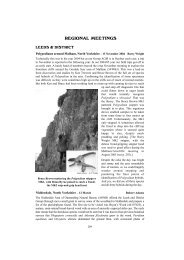Full Contents as pdf File - Natural History Museum
Full Contents as pdf File - Natural History Museum
Full Contents as pdf File - Natural History Museum
Create successful ePaper yourself
Turn your PDF publications into a flip-book with our unique Google optimized e-Paper software.
Our final stop w<strong>as</strong> the Paradise visitor centre. This w<strong>as</strong> my second trip to Mount Rainier,<br />
having travelled there with three naturalists from the Delaware County Institute of Science<br />
in Pennsylvania <strong>as</strong> a graduate student in May 1964. What I remembered most w<strong>as</strong> the<br />
profusion of wildflowers and the compression of se<strong>as</strong>ons from the co<strong>as</strong>t – summer, to the<br />
glaciers of Mt Rainier – spring. This time w<strong>as</strong> no disappointment. The alpine meadow at the<br />
foot of the glaciers w<strong>as</strong> spectacular. A sampling of wildflowers in bloom included:<br />
C<strong>as</strong>telleja parviflora, shooting-star (Dodecatheon jeffreyi), avalanche lily, Eupatorium<br />
occidentale, Lilium columbianum, blue lupine, Phyllodoce empetriformis, false hellebore<br />
(Veratrum viride) and bear gr<strong>as</strong>s (Xerophyllum tenax).<br />
Bainbridge Island Library and Jocelyn Horder’s Garden (Tuesday) Robert Sykes<br />
Our day began, <strong>as</strong> the best days should, with a ferry trip across Puget Sound, the snowcapped<br />
peaks of the Olympic Mountains along the western horizon and a mug of excellent<br />
Seattle coffee in hand.<br />
First call w<strong>as</strong> the fern garden of the Bainbridge Island Library. This is a creation of the<br />
Hardy Fern Foundation <strong>as</strong> part of its mission to encourage the use of ferns in the garden. It<br />
is set in a long strip of ground behind the library, shaded by trees. A ditch along one side<br />
took the drainage from the car park and provided a congenial setting for osmund<strong>as</strong> and<br />
other moisture-loving plants. It w<strong>as</strong> established only three years ago and w<strong>as</strong> m<strong>as</strong>terminded,<br />
with volunteers, by John van den Meerendonk, a practising landscape gardener and newly<br />
installed <strong>as</strong> president of the Hardy Fern Foundation. After initial problems with a heavy<br />
clay soil, it w<strong>as</strong> improved by rotavation and a heavy mulch with rotted bark. Not all the<br />
ferns had survived, and currently the Arachniodes simplicior ‘Variegata’ w<strong>as</strong> struggling,<br />
but most ferns were flourishing and there were particularly fine stands of Woodwardia<br />
fimbriata and Polystichum neolobatum. John had some new ferns ready for planting. It<br />
provided plenty of interest for our group of specialists and certainly fulfilled well its<br />
objective <strong>as</strong> an educational demonstration garden.<br />
On to Jocelyn Horder’s wonderful garden at Poulsbo, where she greeted us and told us the<br />
history of the property. Apparently the site had originally been occupied by the local p<strong>as</strong>tor,<br />
who in the absence of any roads used to row around the creek to service the needs of his<br />
flock. The garden is by the water, facing west to the Olympic Mountains. The main room of<br />
the house h<strong>as</strong> a wall of gl<strong>as</strong>s to take advantage of the view. The sunsets must be superb. A<br />
narrow peninsula runs out from the house dominated by a huge sculptural dead tree,<br />
bleached by the weather. It must have taken courage to leave it when it died, but the effect<br />
is spectacular.<br />
We were greeted at the gate by Denise Kelly, the gardener, and left free to wander. It is a<br />
garden of many elements – a pond surrounded by a rockery, a colonnade hung with<br />
Wisteria seed pods – you don’t see that in England, a great bleached tree root, a trademark<br />
of Dan Robinson, whom we had met at the Elandan Garden and who did part of the design,<br />
a bonsai display, walks by the water; and always the smell of the sea. Some fine ferns too: a<br />
very elegant Polystichum setiferum ‘Multilobum’ with some light cresting, Matteuccia<br />
orientalis, brought <strong>as</strong> a Blechnum from Korea and unfamiliar to many of us. Jocelyn h<strong>as</strong> a<br />
sure touch with Cheilanthes – a fine pot ornamented the porch and there w<strong>as</strong> a wonderful<br />
great patch of Cheilanthes fendleri in the rockery at the front.<br />
Our journey then took us round the co<strong>as</strong>t to Port Angeles. There w<strong>as</strong> no time that evening to go<br />
up the ridge behind to snatch a view of the Olympics, but we did go <strong>as</strong> far <strong>as</strong> the visitor centre,<br />
and a few of us went up a wooded valley on the Peabody Trail. There we saw Polystichum<br />
munitum, Athyrium filix-femina var. cyclosorum, Dryopteris expansa, Gymnocarpium<br />
disjunctum, Adiantum aleuticum, Polypodium glycyrrhiza and Equisetum telmateia. These<br />
seemed to constitute the typical woodland floor pteridophyte flora of the region.<br />
105

















